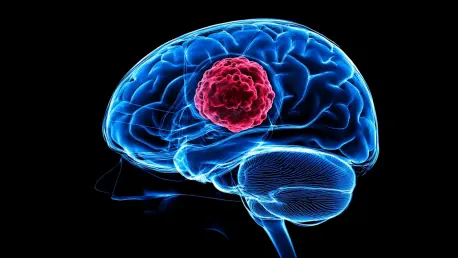The detection and segmentation of brain tumors in MRI images present a critical challenge in medical diagnostics, given their implications for patient treatment plans and outcomes. Despite advancements in imaging techniques and manual segmentation methodologies, the need for precise, automated solutions remains paramount due to the time-intensive and subjective nature of manual methods. As the landscape of deep learning and artificial intelligence continues to evolve, the development of highly automated and accurate tumor segmentation models like the improved YOLOv5s algorithm becomes increasingly vital. This study focuses on the application and enhancement of YOLOv5s for brain tumor MRI image segmentation, aiming to strike a balance between operational efficiency and segmentation accuracy through innovative algorithmic improvements.
1. Image Preparation
One of the initial steps in applying the YOLOv5s model for brain tumor segmentation involves meticulous image preparation. The input image undergoes preprocessing steps, including resizing and normalization, ensuring consistency and compatibility with the model’s requirements. This preprocessing phase is crucial as it standardizes the images, allowing the model to handle a diverse range of MRI scans effectively.
Moreover, within the redesigned YOLOv5s framework, the original Spatial Pyramid Pooling Fast (SPPF) module is replaced by an Atrous Spatial Pyramid Pooling (ASPP) module. ASPP is integral in enhancing the model’s capabilities by utilizing dilated convolutions to improve multi-scale feature representation. By expanding the receptive field, this modification allows the model to detect targets of various scales more accurately. This enhancement is particularly important for identifying the intricate details and diverse morphologies of brain tumors in MRI scans.
The model’s ability to adapt to different scales is critical in clinical settings where tumors may present in varying sizes and shapes. By incorporating ASPP, the model’s proficiency in distinguishing between normal and abnormal tissues is significantly augmented, leading to more precise and reliable segmentation outcomes.
2. Feature Fusion
After preprocessing and initial feature extraction, the next significant stage in the process is feature fusion. The features extracted by the YOLOv5s backbone are forwarded to the neck for further processing, achieving a more nuanced integration of the extracted data. This step is pivotal as it ensures that the model can combine the detailed and contextual information gleaned from the MRI images.
To enhance this process, an attention mechanism is embedded before each detection head within the model. This mechanism dynamically adjusts the weights assigned to different regions in the feature map, ensuring that the model remains highly focused on target-related features. By selectively amplifying significant features and diminishing irrelevant ones, the attention mechanism facilitates more accurate and contextually relevant feature integration.
This enhancement not only improves the model’s ability to select and integrate features but also bolsters its capacity to handle multi-scale targets effectively. Consequently, the use of contextual information is optimized, allowing the model to distinguish more clearly between tumor margins and normal tissue. This step is particularly critical in medical applications where high accuracy in feature detection and integration can significantly impact diagnostic outcomes and subsequent treatment plans.
3. Prediction Generation
Finally, the enhanced YOLOv5s model progresses to the prediction generation phase, wherein the detection head produces prediction results based on the refined feature maps. These results, representing potential tumor locations and segmentations, must undergo a rigorous post-processing step known as non-maximum suppression. This method is essential for removing redundant bounding boxes that could otherwise lead to over-segmentation and inaccuracies in the final output.
Non-maximum suppression eliminates duplicated detections, ensuring that only the most precise and relevant bounding boxes are retained for the final target segmentation outcomes. This refinement step is vital as it directly influences the clarity and accuracy of the segmented tumors, reducing the risk of false positives and enhancing the overall reliability of the model.
The ability of the improved YOLOv5s model to produce high-precision segmentation results with minimized computational load underscores its applicability in real-time clinical scenarios. By maintaining the inherent advantages of YOLOv5s, such as speed and efficiency, and incorporating structural enhancements like ASPP and attention mechanisms, this model sets a new standard for brain tumor MRI segmentation. The improvements ensure that misdiagnosis and oversight are minimized, enabling better-informed surgical and therapeutic decisions, ultimately enhancing patient care and outcomes.









